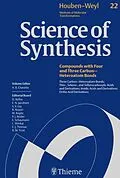Science of Synthesis provides a critical review of the synthetic methodology developed from the early 1800s to date for the entire field of organic and organometallic chemistry. As the only resource providing full-text descriptions of organic transformations and synthetic methods as well as experimental procedures, Science of Synthesis is therefore a unique chemical information tool. Over 1000 world-renowned experts have chosen the most important molecular transformations for a class of organic compounds and elaborated on their scope and limitations. The systematic, logical and consistent organization of the synthetic methods for each functional group enables users to quickly find out which methods are useful for a particular synthesis and which are not. Effective and practical experimental procedures can be implemented quickly and easily in the lab.// The content of this e-book was originally published in June 2005.
Autorentext
Science of Synthesis
Zusammenfassung
Science of Synthesis: Houben-Weyl Methods of Molecular Transformations is the entirely new edition of the acclaimed reference series Houben-Weyl, the standard synthetic chemistry resource since 1909. This new edition is published in English and will comprise 48 volumes published between the years 2000 and 2008.
Science of Synthesis is a quality reference work developed by a highly esteemed editorial board to provide a comprehensive and critical selection of reliable organic and organometallic synthetic methods. This unique resource is designed to be the first point of reference when searching for a synthesis strategy.
- Contains the expertise of presently 400 leading chemists worldwide
- Critically evaluates the preparative applicability and significance of the synthetic methods
- Discusses relevant background information and provides detailed experimental procedures
For full information on the Science of Synthesis series, visit the Science of Synthesis Homepage
Inhalt
22 Introduction
22.1 Product Class 1: Thiocarboxylic Acids and Derivatives
22.1.1 Product Subclass 1: α-Substituted Sulfur Ylides
22.1.2 Product Subclass 2: Thioacyl Halides
22.1.3 Product Subclass 3: Thiocarboxylic O-Acid Esters
22.1.4 Product Subclass 4: Dithiocarboxylic Acid Esters
22.1.5 Product Subclass 5: Selenothiocarboxylic Se-Acid Esters
22.1.6 Product Subclass 6: Tellurothiocarboxylic Te-Acid Esters
22.1.7 Product Subclass 7: Thioamides
22.2 Product Class 2: Selenocarboxylic Acids and Derivatives
22.3 Product Class 3: Tellurocarboxylic Acids and Derivatives
22.4 Product Class 4: Imidic Acids and Derivatives
22.4.1 Product Subclass 1: Carbon-Substituted Iminium Salts
22.4.2 Product Subclass 2: C-Heteroatom-Substituted Nitrones, Other Dipoles
22.4.3 Product Subclass 3: Imidoyl (Imino) Halides
22.4.4 Product Subclass 4: Imidates
22.4.5 Product Subclass 5: Thioimidates and Their Derivatives
22.4.6 Product Subclass 6: Selenoimidates (Imidoselenoates) and Derivatives
22.4.7 Product Subclass 7: Telluroimidates (Imidotelluroates) and Derivatives
22.4.8 Product Subclass 8: N-Alkyl-, N-Aryl-, and N-Hetaryl-Substituted Amidines (Imidamides)
22.4.9 Product Subclass 9: Amidines (Imidamides) N-Substituted by Metals, Halogens, Oxygen, and Other Heteroatoms
22.5 Product Class 5: 2-Functionalized Alkylidenephosphines
22.6 Product Class 6: 2-Functionalized Arsaalkenes and α-Functionalized Arsonium Ylides
22.7 Product Class 7: Ortho Acid Derivatives
22.7.1 Product Subclass 1: Trihalomethyl Compounds
22.7.2 Product Subclass 2: Ortho Esters and Halogenated Derivatives
22.7.3 Product Subclass 3: Trithioortho Esters and Halogenated Derivatives
22.7.4 Product Subclass 4: Triselenoortho Esters and Halogenated Derivatives
22.7.5 Product Subclass 5: Tritelluroortho Esters and Halogenated Derivatives
22.7.6 Product Subclass 6: Ortho Amides (Alkane-1,1,1-triamines)
22.7.7 Product Subclass 7: Tris(diorganophosphino)methanes and Derivatives
